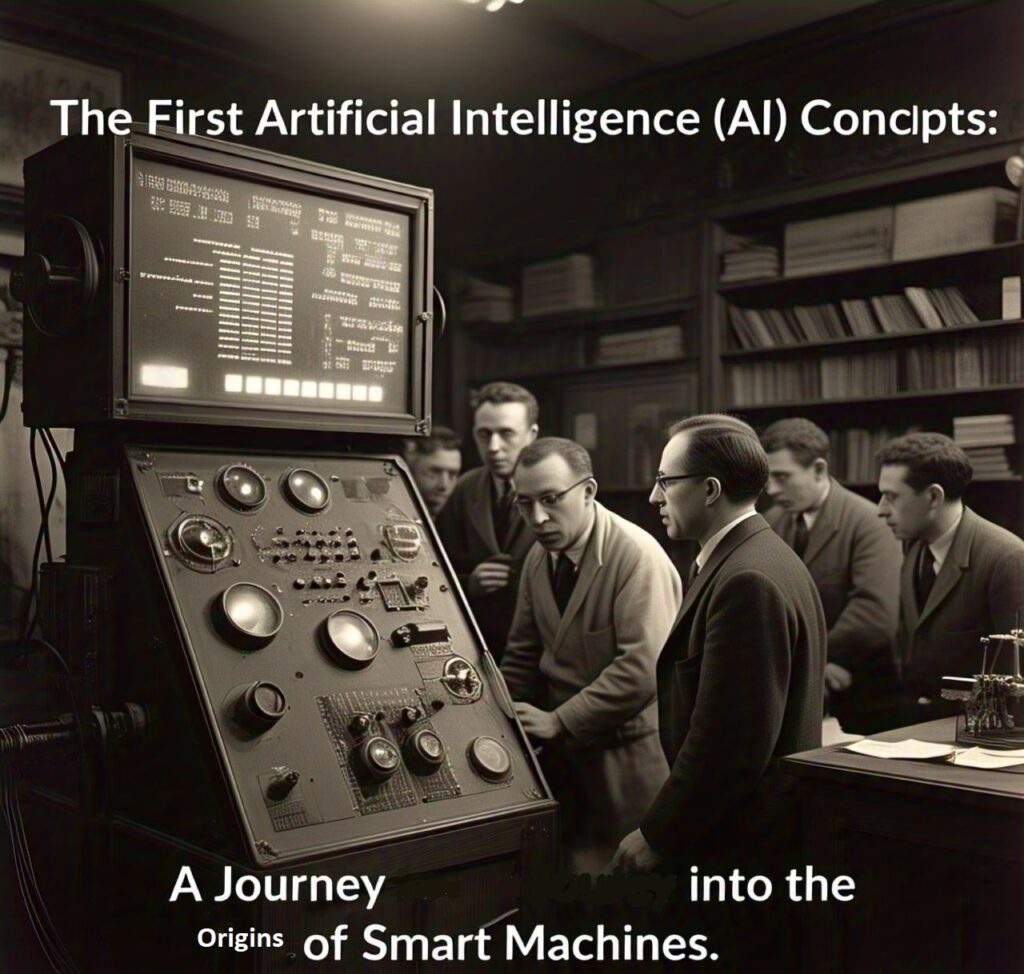
Introduction
Artificial Intelligence (AI) is everywhere today—from voice assistants to self-driving cars. But have you ever wondered where it all began? The first artificial intelligence (AI) concepts date back further than most people think, rooted in philosophy, mathematics, and early computing.
In this blog post, we’ll explore the fascinating origins of AI, the brilliant minds behind its early theories, and how simple ideas evolved into the advanced technology we rely on today. Whether you’re an AI enthusiast or just curious about its history, this deep dive will give you a clear understanding of how AI started—and why it matters now.
Let’s step back in time and uncover the groundbreaking concepts that laid the foundation for modern artificial intelligence.
1. The Philosophical Roots of AI (Before Computers Existed)
Long before computers, philosophers pondered the idea of artificial minds. Ancient Greek myths spoke of mechanical men, while thinkers like René Descartes debated whether machines could think.
In the 17th century, Gottfried Wilhelm Leibniz imagined a universal language of reasoning—a system where logical arguments could be solved like math. Meanwhile, George Boole’s work on binary logic (yes/no, true/false) became crucial for future computing.
These early ideas weren’t called “AI” yet, but they set the stage. The big question was: Can machines mimic human thought? It took centuries, but eventually, science caught up with philosophy.
Transition: Now, let’s fast-forward to the birth of computing.
2. Alan Turing and the First AI Theory
In the 1940s, British mathematician Alan Turing asked a revolutionary question: Can machines think? His famous Turing Test (1950) proposed that if a machine could converse like a human, it could be considered intelligent.
Turing also designed the Turing Machine, a theoretical device that could solve any mathematical problem if given the right instructions. This concept became the backbone of modern computers—and later, AI.
Though computers at the time were primitive, Turing’s ideas proved that artificial intelligence wasn’t just fantasy. His work inspired generations of scientists to push the boundaries of machine learning.
Transition: With Turing’s theories in place, the next step was turning ideas into reality.
3. The Birth of AI: The Dartmouth Conference (1956)
The term “Artificial Intelligence” was officially coined in 1956 at the Dartmouth Conference, organized by John McCarthy, Marvin Minsky, and other pioneers. This event marked the beginning of AI as a scientific field.
Researchers believed that within a few decades, machines would match human intelligence. (Spoiler: They were overly optimistic.) Early projects included programs that could play chess, solve algebra problems, and even mimic human language.
Despite limited computing power, these experiments proved that machines could perform tasks requiring reasoning—a huge leap forward.
Transition: So, what were the first real AI programs?
4. Early AI Programs: Logic and Learning
In the 1950s and 60s, scientists developed the first AI programs. Some key examples:
- The Logic Theorist (1956) – Considered the first AI program, it could solve mathematical theorems like a human.
- ELIZA (1966) – A chatbot that simulated conversation by rephrasing user inputs, tricking some into thinking it was human.
- Shakey the Robot (1966-1972) – The first mobile robot with basic reasoning skills, navigating rooms and solving simple tasks.
These programs were groundbreaking but had limitations. They followed strict rules and couldn’t adapt—unlike today’s AI, which learns from data.
Transition: So why did early AI research slow down?
5. The AI Winters: When Progress Stalled
Despite early excitement, AI faced major setbacks in the 1970s and 80s—periods called “AI Winters.” Funding dried up because machines couldn’t deliver on grand promises.
Problems included:
- Limited computing power – Machines were too slow for complex tasks.
- Lack of data – AI needed vast information to learn, which wasn’t available yet.
- Overhyped expectations – People thought AI would advance much faster than it did.
These challenges forced researchers to rethink their approach, leading to slower but steadier progress.
Transition: Thankfully, AI didn’t stay frozen forever.
6. The Revival: How AI Came Back Stronger
By the 1990s, better computers, more data, and improved algorithms revived AI. Key developments included:
- Machine Learning – Instead of hard-coding rules, AI now learned from patterns.
- The Internet Boom – More data meant smarter AI models.
- Deep Learning (2000s) – Neural networks mimicked the human brain, enabling breakthroughs in image and speech recognition.
This era set the stage for today’s AI revolution, powering everything from Google searches to medical diagnostics.
Conclusion: Why AI’s Origins Matter Today
The first artificial intelligence (AI) concepts weren’t just academic experiments—they shaped the world we live in. From Turing’s theories to today’s self-learning algorithms, each step built the AI we rely on.
Understanding this history helps us appreciate how far AI has come—and where it might go next. Who knows? Maybe the next big breakthrough is just around the corner.
What do you think will be AI’s next big leap?
